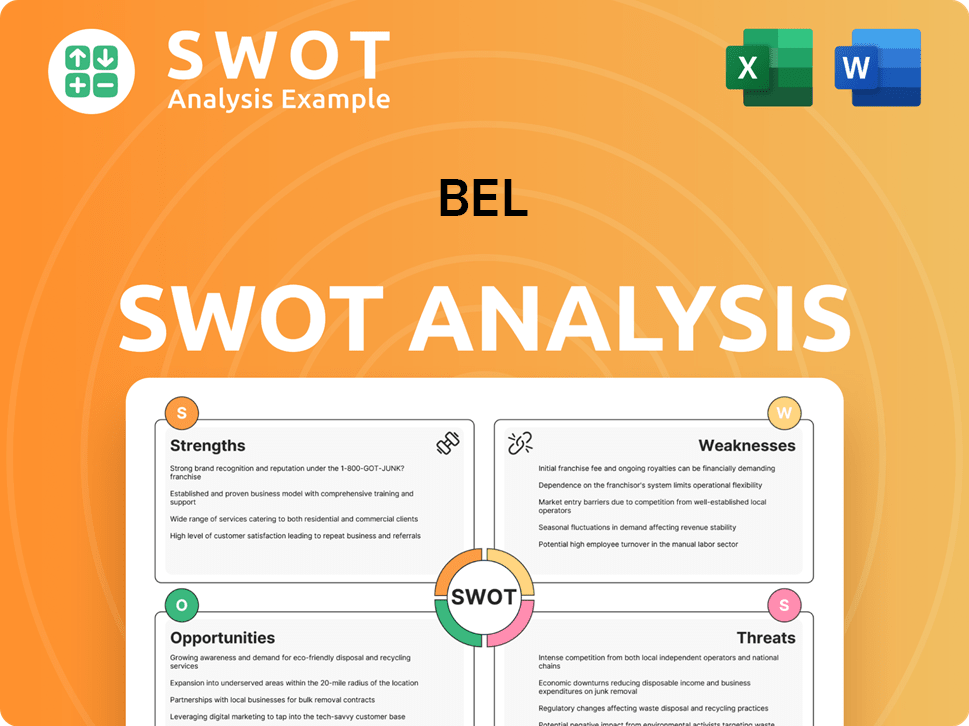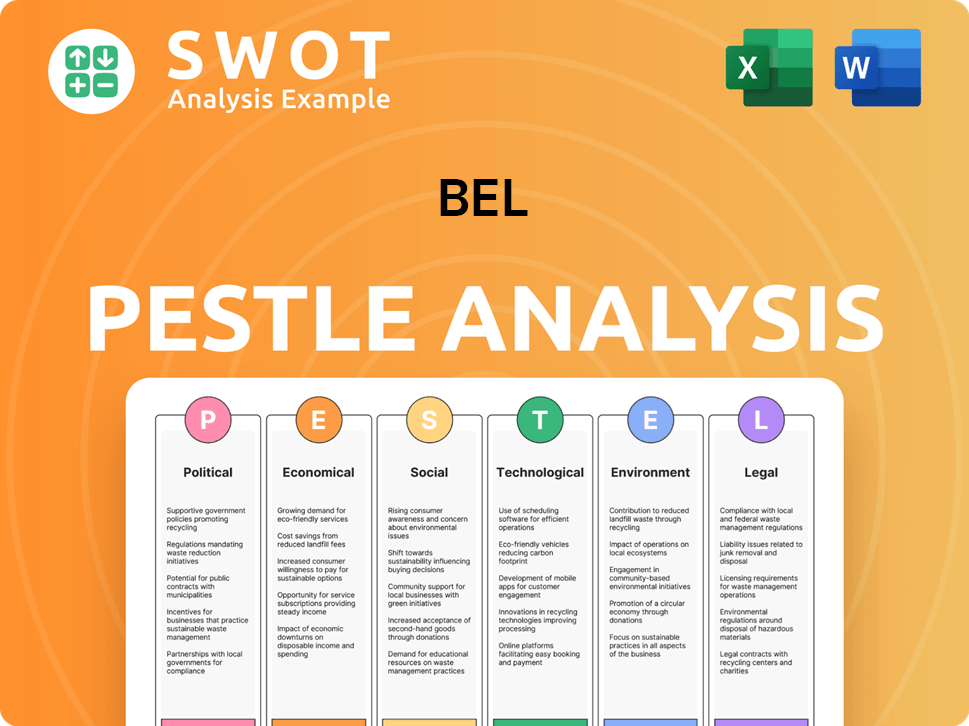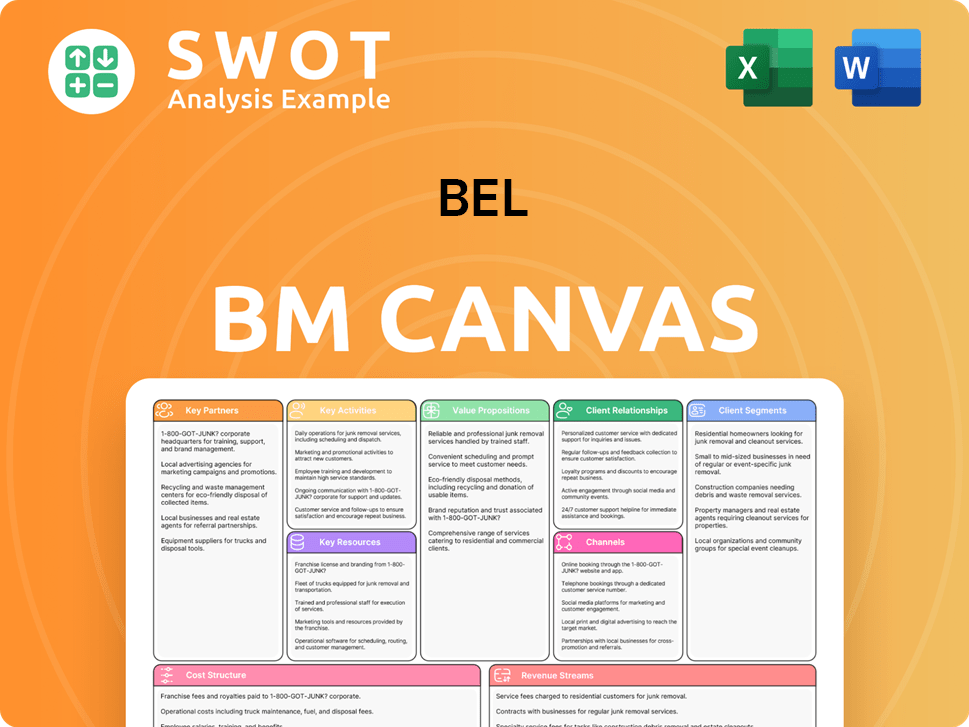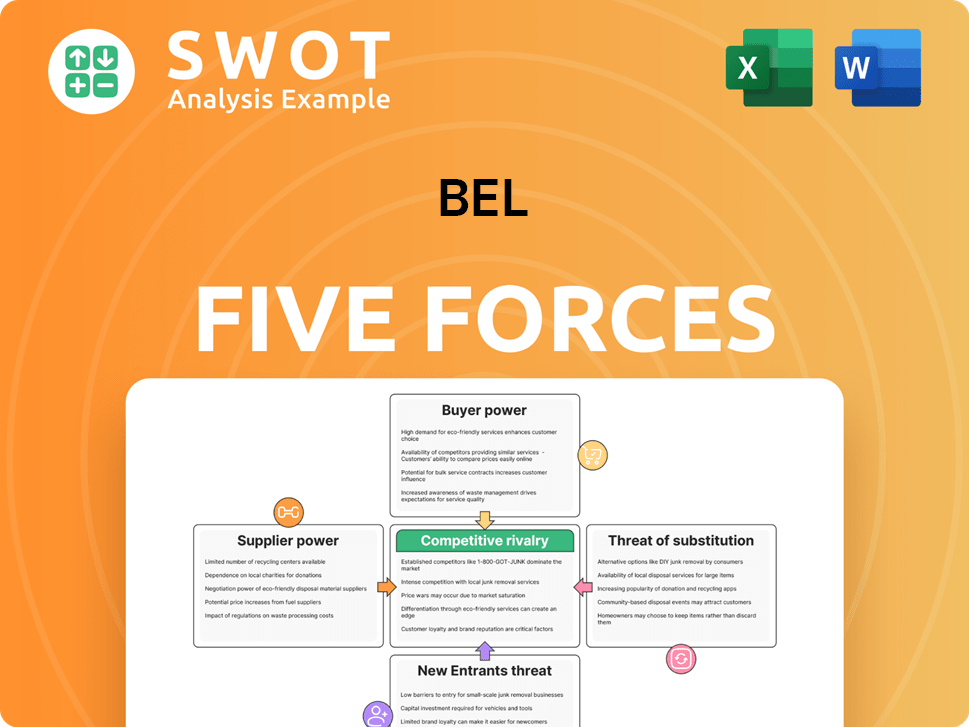Bel Bundle
Who Buys Bel Cheese? Unveiling the Customer Demographics and Target Market of Bel Company
In the competitive global food industry, understanding your audience is paramount. For Bel Company, a leading cheese manufacturer, knowing its customer demographics and target market is the cornerstone of its success. From its origins in France to its global presence today, Bel's evolution reflects a deep understanding of consumer preferences and market segmentation.

This exploration delves into the intricacies of Bel Company's customer profile, examining factors like age range, income levels, and buying behavior. We'll uncover how Bel segments its market and identifies its ideal customer, providing insights into its strategic approach to customer demographics and target market. Understanding the needs and interests of Bel's target audience is key to its continued innovation and market leadership, including customer location data and psychographic profiles.
Who Are Bel’s Main Customers?
Understanding the Revenue Streams & Business Model of Bel requires a deep dive into its primary customer segments. The Bel Company strategically targets a diverse range of consumers, primarily within the Business-to-Consumer (B2C) market. This focus allows for a broad reach, adapting to various consumer needs and preferences, which is crucial in the competitive food industry. The Bel Company's success hinges on accurately identifying and catering to these diverse groups.
A significant portion of Bel Company's customer base comprises families, particularly those with young children. Products like Mini Babybel and The Laughing Cow are popular due to their nutritional value and convenience, appealing to parents seeking healthy and easy-to-manage snacking options. This segment often prioritizes products that are perceived as healthy, fun, and easy to incorporate into daily routines, such as school lunches or on-the-go snacks. Geographically, these consumers are widespread, but particularly concentrated in urban and suburban areas with higher disposable incomes, reflecting a focus on convenience and quality.
Beyond families, Bel Company also targets young adults and health-conscious individuals. This segment is driven by lifestyle factors such as busy schedules and a desire for healthier eating habits. The company's portfolio includes products that align with these preferences, offering convenient and portion-controlled options. The company has also expanded into plant-based cheese, a move that aligns with current market trends and caters to those seeking alternatives.
This is a core demographic for products like Mini Babybel and The Laughing Cow. These consumers prioritize nutritional value, convenience, and ease of use. They are often found in urban and suburban areas with higher disposable incomes, reflecting their focus on quality and convenience.
This segment seeks convenient, portion-controlled snacks that fit a busy lifestyle. They are driven by a desire for healthier eating habits and are open to trying new products. This group often includes those interested in plant-based options.
This group is increasingly interested in plant-based alternatives. The company's expansion into plant-based cheese products directly targets this segment, capitalizing on the growing demand for flexitarian, vegetarian, and vegan options. This strategic shift reflects evolving dietary preferences.
Brands like Boursin cater to an older, more discerning demographic. This segment appreciates premium ingredients and sophisticated flavors for entertaining or personal enjoyment. They are willing to pay for quality, convenience, and brand recognition.
The Bel Company employs a targeted approach to market segmentation, focusing on specific consumer needs and preferences. This strategy allows the company to tailor its product offerings and marketing efforts effectively. The company's understanding of its customer demographics is crucial for its continued success and growth.
- Families with Young Children: Primary focus due to nutritional value and convenience.
- Young Adults and Health-Conscious Individuals: Seeking convenient and portion-controlled snacks.
- Health-Focused Consumers: Increasing interest in plant-based alternatives.
- Gourmet Food Enthusiasts: Appreciating premium ingredients and sophisticated flavors.
Bel SWOT Analysis
- Complete SWOT Breakdown
- Fully Customizable
- Editable in Excel & Word
- Professional Formatting
- Investor-Ready Format

What Do Bel’s Customers Want?
Understanding the customer needs and preferences is crucial for the success of any company, and for Bel Company, this involves a deep dive into what drives consumer choices. The primary drivers for Bel Company’s customers are convenience, health, taste, and versatility. These factors influence purchasing decisions and brand loyalty, shaping the company’s market strategies.
For core brands like Mini Babybel and The Laughing Cow, the focus is on ease of consumption and portion control, appealing to health-conscious consumers. Taste and texture are paramount, especially for brands like Kiri and Boursin, which offer distinct flavor profiles. These preferences guide product development and marketing efforts, ensuring alignment with consumer expectations.
Bel Company's target market is diverse, but key segments include families, health-conscious individuals, and those seeking convenient snacking options. These segments have different needs and motivations, influencing how Bel Company positions its products and communicates its value proposition. Understanding these nuances is essential for effective market segmentation and achieving customer satisfaction.
Customers prioritize products that are easy to consume, especially for on-the-go snacking and quick meals. Individual packaging, like that of Mini Babybel, directly addresses this need. This convenience is particularly appealing to busy families and individuals seeking hassle-free options.
Health-conscious consumers are drawn to products with perceived nutritional benefits, such as calcium content. Portion control, offered by individual servings, supports healthy eating habits. The increasing demand for plant-based options reflects this growing focus on wellness.
Taste and texture are critical decision-making factors, with brands like Kiri and Boursin offering distinct flavor profiles. Consumer preferences vary, from creamy consistencies to sophisticated flavors, influencing product choices. The variety of flavors caters to different palates.
Brand recognition and positive associations, often built over time, play a significant role in purchasing decisions. Consistent quality and effective marketing reinforce brand loyalty. Childhood memories associated with brands can also influence consumer choices.
Product usage varies from daily snacking to occasional culinary applications, depending on the brand. Some consumers use products for quick snacks, while others incorporate them into meals. Versatility enhances the appeal of the products across different consumer needs.
Consumers seek simple, wholesome snacks that fit their lifestyles. Brands like Boursin cater to those seeking sophisticated flavors. Aspirational drivers include a desire for ease in entertaining and enjoyment of premium products.
Bel Company actively addresses customer pain points, such as the messiness of traditional cheese, through innovative packaging and product formats. Customer feedback and market trends, including the rising demand for plant-based options, drive product development. For example, the introduction of plant-based versions of popular brands caters to consumers seeking dairy-free alternatives. Marketing strategies are tailored to specific segments, with a focus on nutritional value and fun for families, and convenience and flavor for adults. Promotional campaigns often feature active lifestyles and healthy eating, aligning with consumer preferences for wellness. In 2024, the global cheese market was valued at approximately $130 billion, with continued growth expected, driven by evolving consumer preferences and demand for convenient, healthy, and flavorful options. The emphasis on these factors ensures that Bel Company remains competitive and relevant in the market.
Bel PESTLE Analysis
- Covers All 6 PESTLE Categories
- No Research Needed – Save Hours of Work
- Built by Experts, Trusted by Consultants
- Instant Download, Ready to Use
- 100% Editable, Fully Customizable

Where does Bel operate?
The geographical market presence of the company is extensive, spanning across multiple continents. Its primary focus areas include Europe, North America, and parts of Asia and Africa. This strategic distribution allows the company to cater to diverse consumer bases and capitalize on varying market dynamics. Understanding the geographical spread is crucial for analyzing the company's market segmentation and customer demographics.
Europe serves as a cornerstone for the company, with strong brand recognition and significant market share in countries like France, the UK, Germany, and Spain. In North America, particularly the United States, the company has established a strong presence, especially in the snacking cheese category. The company's approach involves adapting its strategies to suit regional preferences, including product variations and marketing campaigns tailored to local tastes.
Recent expansions highlight a focus on emerging markets in Asia and Africa, indicating a strategic move to diversify its global footprint. These expansions are driven by the growing middle class and increasing demand for convenient, branded food products. This geographical diversification is a key element of the company's growth strategy, reflecting its commitment to adapting to global consumer preferences and market opportunities. For a deeper dive into their marketing strategies, consider exploring the Marketing Strategy of Bel.
Europe remains a key market for the company, particularly in France, where it originated. The company's traditional cheese brands, like Leerdammer, have a strong presence. This region benefits from established brand recognition and consumer trust, driving consistent sales and market share.
North America, especially the United States, is a crucial growth market. Brands like Mini Babybel and The Laughing Cow have gained a strong foothold. The focus is on expanding distribution and increasing brand visibility to cater to the preference for convenience and portioned foods.
The company tailors its approach to different regions by adapting flavors and product formats. This includes specific product variations or sizes for different markets. This market segmentation strategy ensures that offerings align with regional tastes and dietary requirements, enhancing consumer appeal.
Recent expansions focus on emerging markets in Asia and Africa, where the middle class is growing. This strategic move targets the increasing demand for branded, convenient food products. This expansion is part of a broader effort to diversify the global footprint.
The company's success is rooted in understanding and adapting to local market dynamics. This includes tailoring marketing campaigns, product offerings, and distribution strategies to meet the specific needs and preferences of each region. This approach is critical to the company's ability to maintain and grow its market share.
- Customer Demographics: The company targets a broad range of consumers, with variations in age, income, and lifestyle across different regions.
- Target Market: The company's target market includes families, young adults, and individuals seeking convenient and healthy snacking options.
- Buying Behavior: Consumer behavior varies by region, with factors like cultural preferences, dietary habits, and purchasing power influencing buying decisions.
- Market Segmentation: The company segments its market based on geography, demographics, and psychographics to tailor its products and marketing efforts.
Bel Business Model Canvas
- Complete 9-Block Business Model Canvas
- Effortlessly Communicate Your Business Strategy
- Investor-Ready BMC Format
- 100% Editable and Customizable
- Clear and Structured Layout

How Does Bel Win & Keep Customers?
The [Company Name] employs a comprehensive strategy for acquiring and retaining customers, utilizing a blend of traditional and digital marketing, strategic sales tactics, and initiatives aimed at fostering brand loyalty. This multi-faceted approach is crucial for maintaining a strong position in the competitive snacking market. Understanding the customer demographics and defining the target market are fundamental to [Company Name]'s success.
For customer acquisition, [Company Name] uses extensive advertising campaigns across various channels. These include television, print media, and digital platforms. Social media marketing, particularly on platforms like Facebook, Instagram, and TikTok, plays a significant role in engaging younger demographics. This is complemented by influencer marketing, which helps reach new consumers through health, wellness, and family-focused content creators. Strategic placement in major retail chains and supermarkets ensures high visibility and accessibility of products.
Customer retention is a key focus for [Company Name]. This is achieved by building strong brand equity through consistent product quality and positive brand experiences. The company also leverages customer data and market segmentation to tailor marketing messages and product offerings to specific consumer groups. This includes promoting plant-based options to vegan or flexitarian audiences through targeted digital ads. Over time, [Company Name] has increased investment in online marketing and e-commerce capabilities, particularly accelerated by shifts in consumer behavior, which has impacted customer loyalty by enabling more direct engagement.
Advertising campaigns are crucial for reaching the target market. Television and print media are still used, but digital platforms are increasingly important. Digital advertising allows for targeted campaigns on platforms like Facebook, Instagram, and TikTok, which are key for engaging younger demographics and promoting the convenience and versatility of its snacking cheese brands.
Social media marketing is a key component of [Company Name]'s customer acquisition strategy. Platforms like Facebook, Instagram, and TikTok are used extensively. These platforms allow for targeted campaigns designed to engage younger demographics and highlight the convenience and versatility of the products. According to Statista, social media ad spending in the food industry is projected to reach $13.8 billion in 2024.
Influencer marketing is a growing channel for reaching new consumers. [Company Name] partners with health and wellness influencers and family-focused content creators. This strategy helps to build brand awareness and credibility. The influencer marketing spend is expected to reach $21.6 billion in 2024, according to Influencer Marketing Hub.
Sales tactics include strategic placement in major retail chains and supermarkets. In-store promotions and sampling events are also crucial for driving initial purchases. These tactics ensure high visibility and accessibility of products. The convenience store market in the U.S. generated over $700 billion in sales in 2023, according to the NACS.
The [Company Name] strategically uses market segmentation to tailor its marketing messages. For example, they promote plant-based options to vegan or flexitarian audiences through targeted digital ads. CRM systems are likely employed to manage customer interactions and track purchasing patterns. The shift to digital transformation has enabled more direct engagement with consumers, which has likely influenced customer loyalty. You can learn more about the company's history in Brief History of Bel.
Customer data and market segmentation are used to tailor marketing messages and product offerings. This allows the company to target specific consumer groups effectively. This is essential for understanding the needs of the target market.
The company has increased investment in online marketing and e-commerce. This shift has enabled more direct engagement with consumers. This has likely influenced customer loyalty and reduced churn rates.
CRM systems are likely employed to manage customer interactions and track purchasing patterns. While specific details are proprietary, CRM is crucial for understanding customer behavior and preferences. The global CRM market is projected to reach $96.3 billion by 2027, according to Statista.
Loyalty programs, though not publicly detailed for direct consumer participation, could exist at a retail partnership level or through digital engagement initiatives. These programs encourage repeat purchases and build customer loyalty. The effectiveness of loyalty programs can increase customer lifetime value.
After-sales service manifests as responsiveness to consumer feedback and inquiries, often managed through dedicated customer service channels. This helps build a positive brand image and fosters customer loyalty. Excellent customer service can increase customer satisfaction.
Building strong brand equity through consistent product quality and positive brand experiences is a key focus. This helps create a loyal customer base. Strong brand equity can lead to higher profitability.
Bel Porter's Five Forces Analysis
- Covers All 5 Competitive Forces in Detail
- Structured for Consultants, Students, and Founders
- 100% Editable in Microsoft Word & Excel
- Instant Digital Download – Use Immediately
- Compatible with Mac & PC – Fully Unlocked

Related Blogs
Disclaimer
All information, articles, and product details provided on this website are for general informational and educational purposes only. We do not claim any ownership over, nor do we intend to infringe upon, any trademarks, copyrights, logos, brand names, or other intellectual property mentioned or depicted on this site. Such intellectual property remains the property of its respective owners, and any references here are made solely for identification or informational purposes, without implying any affiliation, endorsement, or partnership.
We make no representations or warranties, express or implied, regarding the accuracy, completeness, or suitability of any content or products presented. Nothing on this website should be construed as legal, tax, investment, financial, medical, or other professional advice. In addition, no part of this site—including articles or product references—constitutes a solicitation, recommendation, endorsement, advertisement, or offer to buy or sell any securities, franchises, or other financial instruments, particularly in jurisdictions where such activity would be unlawful.
All content is of a general nature and may not address the specific circumstances of any individual or entity. It is not a substitute for professional advice or services. Any actions you take based on the information provided here are strictly at your own risk. You accept full responsibility for any decisions or outcomes arising from your use of this website and agree to release us from any liability in connection with your use of, or reliance upon, the content or products found herein.